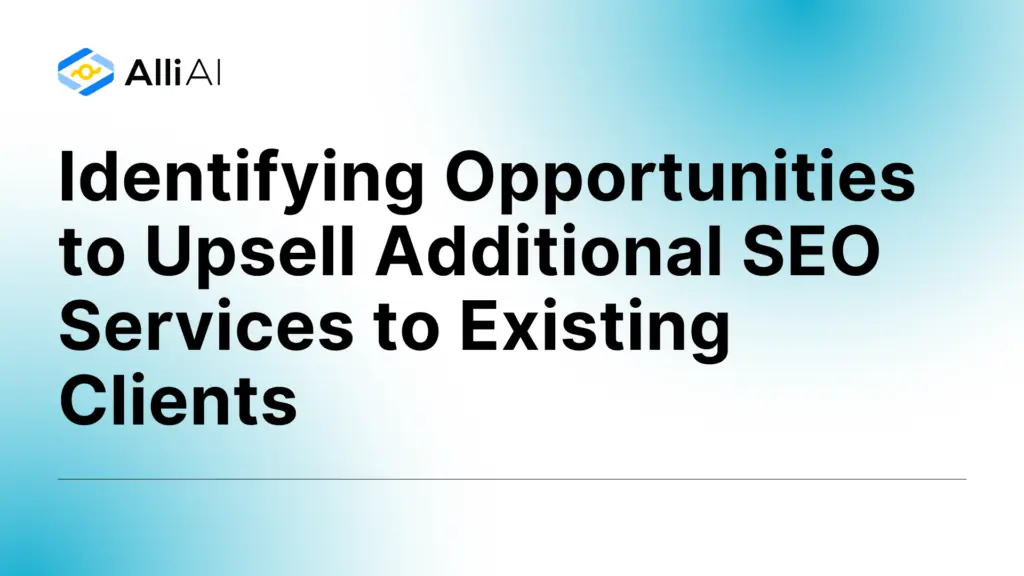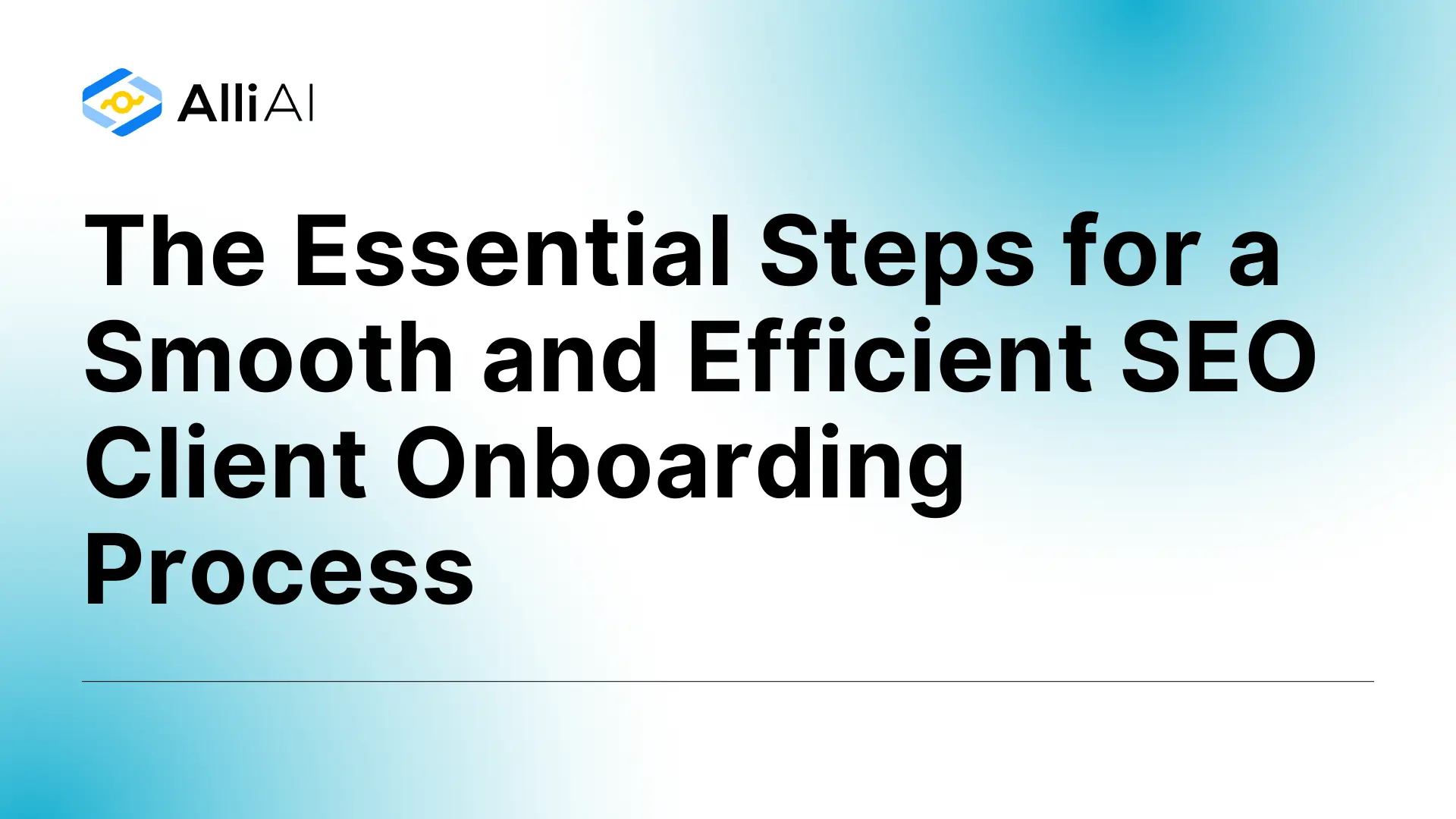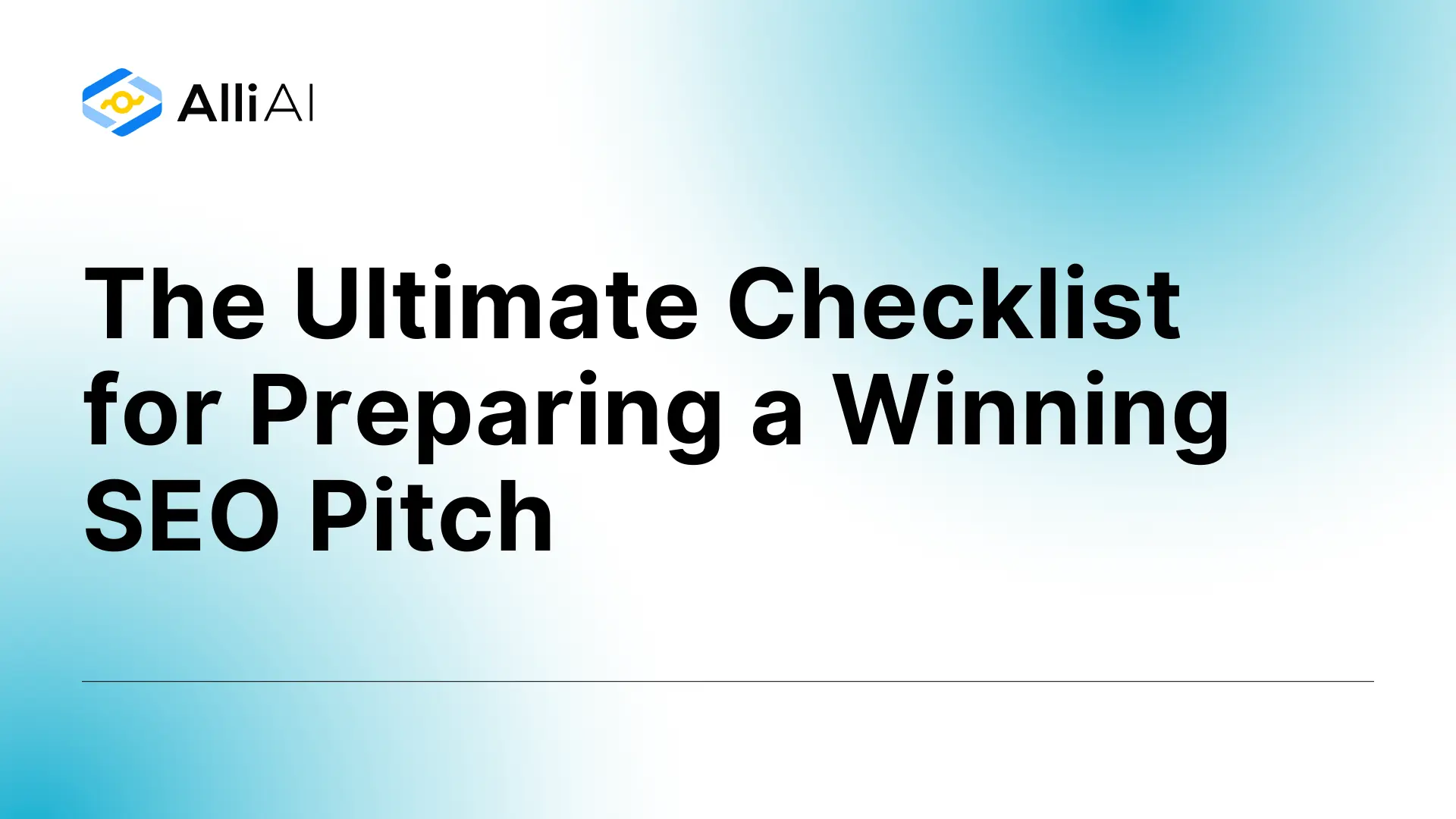Looking to grow your agency’s revenue while delivering more value to existing clients? The secret lies in strategically identifying and presenting SEO upsell opportunities that align perfectly with your clients’ evolving needs.
In my years helping agencies scale their SEO service offerings, I’ve discovered that most leave significant revenue on the table by failing to systematically spot and present high-value upsell opportunities. The solution is a data-driven approach to identifying genuine client needs based on performance gaps, competitive intelligence, and emerging trends.
This approach has helped numerous agencies increase their average client value by 30-50% while significantly improving client retention rates. Why? Because properly positioned upsells solve real problems and deliver measurable results, transforming your role from service provider to strategic partner.
Let’s walk through the exact framework you need to identify, position, and close SEO upsell opportunities that boost your revenue while delivering exceptional client value.
Step #1: Conduct Foundational Client Analysis to Uncover True Needs
The foundation of any successful upsell strategy begins with a deep understanding of your client’s current performance. This goes far beyond basic keyword rankings and requires examining metrics that reflect genuine business impact.
Start by analyzing performance holistically:
Traffic quality is more important than raw traffic numbers. Use Google Analytics 4 to evaluate:
- Engagement rate (replacing the old bounce rate)
- Average engagement time
- Scroll depth on key pages
- Conversion rates specifically from organic traffic
For example, if you notice the client has healthy organic traffic but poor conversion rates compared to other channels, this immediately signals a potential upsell opportunity focused on conversion rate optimization.
Align with evolving business objectives:
Client goals change over time. What might have been important when they first signed can shift dramatically a year later.
Schedule quarterly business alignment calls that focus specifically on:
- Current business priorities and KPIs
- Changes in target audiences or markets
- New product or service offerings
- Performance of different customer segments
For example, if your client initially focused on lead generation but is now prioritizing customer retention, this presents an opportunity to upsell content marketing services targeting existing customers.
Pro tip: Don’t rely solely on your main client contact for business objective information. Request a quarterly call that includes higher-level stakeholders (marketing directors, CMOs) to understand broader business strategies.
Leverage analytics platforms strategically:
Most agencies only scratch the surface of what’s possible with analytics tools. Use GA4, Search Console, and dedicated SEO platforms to uncover specific upsell opportunities:
- Set up custom reports in GA4 that segment organic traffic by landing page type, conversion path, and user journey
- Use Search Console to identify specific queries where you’re getting impressions but low CTR
- Utilize SEMrush or Ahrefs to benchmark performance against competitors across multiple metrics
Critically, you need to move beyond simply reporting what happened to explaining why metrics changed and what specific actions could improve performance.
For instance, if Search Console shows you’re ranking on page two for several high-volume commercial intent keywords, this directly justifies an upsell for advanced on-page optimization or a backlink acquisition package.
| Metric Category | Specific Metric | Tool(s) | Relevance to Upselling |
| Traffic Quality | Organic Traffic Volume | GA4, GSC | Baseline indicator; significant drops may signal issues needing advanced diagnostics. |
| Organic Traffic Relevance (Queries) | GSC | Identifies if traffic aligns with valuable keywords; misalignment suggests keyword strategy refinement. | |
| New vs. Returning Organic Users | GA4 | Indicates audience loyalty & reach; low return rate may suggest engagement/content issues. | |
| Engagement | Avg. Engagement Time per Session | GA4 | Low engagement suggests content quality/relevance issues, opportunity for content enhancement. |
| Engagement Rate | GA4 | Low rate indicates poor user interaction, opportunity for UX/content optimization. | |
| Bounce Rate (Contextual) | GA4 | High rates on key pages suggest UX/content/intent mismatch, opportunity for CRO/content work. | |
| Scroll Depth | GA4 (via GTM), Hotjar | Users not reaching CTAs suggests page layout/content flow issues, UX/design upsell. | |
| Conversion | Organic Conversion Rate | GA4 | Low rates indicate friction; opportunity for CRO, landing page optimization, technical fixes. |
| Goal Completions (Organic) | GA4 | Tracks specific desired actions; low completions suggest funnel/content issues. | |
| Assisted Organic Conversions | GA4 (Multichannel Funnels) | Shows SEO’s supporting role; highlights value beyond last-click, justifying ongoing investment. | |
| Cost Per Organic Lead/Acquisition | GA4 + Client Data/CRM | High cost suggests inefficiency; opportunity for targeting refinement, CRO. | |
| Technical Health | Core Web Vitals (LCP, INP, CLS) | GSC, PageSpeed Insights | Poor scores impact UX & rankings; clear opportunity for technical SEO upsell. |
| Mobile Usability Issues | GSC | Errors indicate poor mobile experience; opportunity for mobile optimization services. | |
| Index Coverage Errors | GSC | Prevents pages from ranking; opportunity for technical audit/fixes. | |
| Site Security (HTTPS) | Browser, GSC, Audit Tools | Lack of HTTPS is a risk; opportunity for security implementation/audit. | |
| Authority/Off-Page | Referring Domains (Quality/Qty) | Ahrefs, SEMrush, Moz Pro | Low quality/quantity vs. competitors suggests need for link building/digital PR. |
| Domain Authority/Authority Score | Moz Pro, SEMrush | Benchmark vs. competitors; lagging score justifies authority-building efforts. | |
| Backlink Profile Health (Toxicity) | SEMrush, Ahrefs | High toxicity risks penalties; opportunity for backlink audit/disavow services. |
Step #2: Perform Strategic Gap Analysis to Identify Missed Opportunities
Once you understand the client’s current performance, the next step is identifying specific areas where they’re missing potential growth. This gap analysis provides concrete justification for recommending additional services.
Master keyword gap analysis:
Use tools like SEMrush’s Keyword Gap or Ahrefs’ Content Gap to find valuable keywords where:
- Competitors rank in the top 10-20 positions
- Your client has little or no visibility
- Search volume and intent align with client goals
When prioritizing these keyword opportunities, focus on:
- Keywords with sufficient search volume (typically 200+ monthly searches for most industries)
- Terms with manageable difficulty scores relative to the client’s domain authority
- Keywords with commercial or transactional intent if revenue is the primary goal
Warning: Don’t just present a list of missing keywords. Instead, group them into strategic clusters that represent specific content or optimization opportunities. This transforms your upsell from “we need to target these keywords” to “we’ve identified a major content opportunity around [topic cluster] that could drive significant qualified traffic.”
Conduct comprehensive content gap analysis:
Go beyond keywords to identify missing topics, formats, and audience needs:
- Analyze competitor content strategies to identify topic areas where your client lacks depth
- Assess different content formats (video, interactive tools, guides) that competitors leverage effectively
- Review “People Also Ask” questions, forum discussions, and customer support inquiries to identify unaddressed audience needs
For example, if you discover competitors are achieving significant engagement through video tutorials while your client relies solely on text content, this creates a clear opportunity to upsell video production and optimization services.
Use competitor benchmarking to pinpoint deficiencies:
Compare your client’s performance across key metrics against their main competitors:
- Organic traffic and visibility trends
- Rankings for shared core keywords
- Backlink profile quality and growth rate
- Technical performance (Core Web Vitals, mobile experience)
When you identify a significant gap, diagnose why it exists. Are competitors winning due to:
- Superior content depth or expertise demonstration?
- Stronger backlink profiles?
- Better technical implementation?
- More diverse content formats?
This diagnosis directly informs your upsell recommendation. If benchmarking reveals competitors have vastly superior backlink profiles, you’ve built a strong case for proposing advanced link acquisition services.
Remember: Effective gap analysis isn’t just identifying what’s missing—it’s translating those gaps into tangible business opportunities with clear ROI potential.
Step #3: Leverage Competitor Intelligence for Strategic Advantage
Understanding competitors is crucial for developing effective upsell strategies. Move beyond basic gap analysis to understand the specific tactics driving competitor success.
Implement advanced competitor analysis:
Dissect competitor strategies across multiple SEO dimensions:
- Keyword strategy: Analyze not just which keywords competitors target, but how they target them. Are they focusing on informational versus commercial intent? Are they organizing content around tight topic clusters?
- Content quality: Assess competitors’ demonstration of Experience, Expertise, Authoritativeness, and Trustworthiness (E-E-A-T). Are they using author bios with credentials? Citing authoritative sources? Showcasing case studies or first-hand experience?
- Backlink acquisition: Analyze the types of sites linking to competitors, their anchor text distribution, and link velocity. Are they earning links through high-quality content, outreach campaigns, or digital PR?
- Technical implementation: Examine how competitors handle site architecture, schema markup, and Core Web Vitals optimization. Are they effectively using structured data to win rich snippets?
Understanding these nuances is critical. If a competitor ranks highly despite mediocre content due to a massive backlink profile, simply upselling more content creation won’t be sufficient—you’ll need to propose strategic link acquisition services as well.
Use research tools effectively:
Master the advanced features of platforms like SEMrush and Ahrefs:
- SEMrush: Utilize Keyword Gap, SERP Gap Analyzer, Backlink Analytics, and Traffic Analytics to develop a comprehensive view of competitor performance
- Ahrefs: Leverage Site Explorer, Content Gap, and Keywords Explorer to identify specific opportunities
Set up continuous monitoring of competitors to track real-time changes in rankings, new content publication, and significant backlink acquisitions. This ongoing intelligence helps you present timely upsell opportunities when a competitor makes a significant move.
Translate competitor insights into actionable opportunities:
The real value of competitor intelligence is its translation into specific upsell proposals. Present opportunities in these frameworks:
- Exploiting weaknesses: “Competitor A ranks well for ‘service X’ but their content is outdated and lacks depth. We can create a comprehensive, up-to-date guide to capture this traffic.”
- Replicating proven success: “Competitor C generates significant engagement with their ‘how-to’ video series. Developing a similar series tailored to your specific expertise could attract a valuable audience.”
When presenting these opportunities, always connect the competitor insight directly to the proposed service and expected business benefit.
Pro tip: Present competitive insights as a narrative rather than raw data. Instead of saying “Competitor X has 500 more backlinks than you,” say “Competitor X has systematically built relationships with industry publications over the past year, resulting in 40% more organic traffic to their service pages—here’s how we can implement a similar strategy with your unique advantages.”
Step #4: Expand Your Service Portfolio with Advanced and Specialized Offerings
As clients mature and markets become more competitive, basic SEO services often prove insufficient. Developing and upselling advanced, specialized services can deliver significant value while increasing your revenue per client.
Consider these high-value advanced technical SEO opportunities:
- JavaScript SEO: For clients with modern web applications built on React, Angular, or Vue.js, optimizing JavaScript rendering is critical for search visibility
- Advanced schema markup: Implementing sophisticated schema beyond basic types (detailed Product schema, VideoObject, FAQPage schema) can dramatically enhance SERP visibility
- Core Web Vitals optimization: Moving beyond basic PageSpeed recommendations to perform in-depth analysis and optimization of LCP, INP, and CLS
- Enterprise-level technical solutions: For large sites, services focused on architecture optimization, crawl budget management, and log file analysis deliver substantial value
For example, if your client’s site uses heavy JavaScript frameworks and a technical audit reveals rendering issues, this justifies an upsell focused specifically on JavaScript SEO implementation.
Develop strategic content and authority building services:
As search engines prioritize helpful, reliable content, consider these upsell opportunities:
- Topic cluster strategy: Developing comprehensive pillar pages supported by clusters of related content
- E-E-A-T enhancement: Implementing specific strategies to showcase experience, expertise, authoritativeness, and trustworthiness
- Content format diversification: Expanding beyond blog posts to include video, interactive tools, or data-driven visual content
- Strategic content promotion: Integrating content creation with proactive amplification strategies
If your client is struggling to rank despite solid on-page optimization, an E-E-A-T enhancement package that systematically improves author credibility, content depth, and expert demonstration can be a powerful upsell.
Offer sophisticated link acquisition services:
Quality backlinks remain critical for search visibility. Consider these specialized offerings:
- Digital PR integration: Leveraging public relations tactics to earn mentions from news outlets and industry publications
- Strategic outreach campaigns: Building relationships with relevant sites for guest posting and resource link opportunities
- Link-worthy asset creation: Developing original research, data studies, or interactive tools specifically designed to attract links
This approach transforms link building from a commodity service to a strategic asset that directly enhances domain authority and rankings.
Warning: Only upsell services your agency can deliver effectively. If you lack genuine expertise in areas like enterprise technical SEO or digital PR, consider strategic partnerships or white-label arrangements before promising these specialized services.
| Service Area | Standard Service Example | Advanced/Upsell Service Example | Key Benefit/Value Driver of Upsell |
| Technical SEO | Basic Audit Fixes (404s, basic metas), Sitemap Submittal | JavaScript Rendering Optimization, Advanced Schema Implementation, Core Web Vitals Deep Dive, Log File Analysis | Improved indexing of complex sites, enhanced SERP features, superior UX & speed, deeper bot insights |
| Content | Blog Post Creation, Basic On-Page Optimization | Topic Cluster Strategy Dev., E-E-A-T Enhancement, Video/Podcast Production, Interactive Content | Increased topical authority, enhanced trust signals, higher engagement, differentiation |
| Link Building | Directory Submissions, Basic Outreach | Strategic High-Authority Link Acquisition, Digital PR Campaigns, Broken Link Building | Stronger authority signals, improved rankings, brand visibility, sustainable link profile |
| Local SEO | Basic GBP Setup & Optimization, NAP Consistency Check | Advanced Local Schema, Citation Building & Management, Review Generation Strategy | Enhanced local pack visibility, improved local reputation, more qualified local leads |
| Strategy Scope | Single Geographic Focus (e.g., Local OR National) | International SEO Implementation (Hreflang, localization), Multi-Regional Strategy | Expanded market reach, global brand presence, targeted international traffic |
| Emerging Search | Keyword Research for Text Queries | Voice Search Optimization (FAQ content, Speakable schema), Video SEO (YouTube & Google) | Visibility in voice assistants, increased video engagement & reach, future-proofing |
| Niche Focus | General Website SEO | E-commerce Platform Optimization, Enterprise SEO Consulting & Management | Tailored solutions for specific business models/scales, handling complexity effectively |
Step #5: Proactively Spot Opportunities Through Audits and Trends
The most successful agencies don’t wait for clients to request additional services—they proactively identify opportunities through regular audits and awareness of industry trends.
Use preliminary audits to diagnose specific weaknesses:
Implement a schedule of regular mini-audits focusing on key areas:
- Technical health: Check for crawl errors, indexing issues, site speed bottlenecks, and mobile-friendliness problems
- On-page elements: Review title tags, meta descriptions, header usage, internal linking structure, and content quality
- Off-page factors: Assess the backlink profile for quantity, quality, and potential toxicity
These audits provide objective, data-driven evidence of problems that justify specific upsell recommendations. For instance, discovering consistently slow page load times directly supports an upsell for technical SEO focused on Core Web Vitals optimization.
Pro tip: Don’t wait for quarterly or annual reviews to present audit findings. When you identify a significant issue, schedule a special call specifically to address that opportunity. The timeliness demonstrates your proactive approach and creates urgency around the solution.
Capitalize on current and emerging SEO trends:
Stay informed about industry developments and leverage them for upsell opportunities:
- AI’s impact on search: The rise of AI Overviews and Answer Engine Optimization (AEO)
- E-E-A-T emphasis: Google’s continued focus on Experience, Expertise, Authoritativeness, and Trustworthiness
- Multi-modal search: Increasing use of voice, video, and image search
- Community and forum visibility: Growing prominence of platforms like Reddit in SERPs
Translate these macro trends into specific upsell recommendations:
“Given the rise of AI Overviews, optimizing your key service pages with concise answers and clear structure could significantly increase your visibility in these new features.”
“With users increasingly asking conversational questions, developing an FAQ section optimized for voice search could capture valuable long-tail traffic.”
Develop new service offerings based on industry evolution:
As certain trends solidify, formalize new service packages around them:
- Answer Engine Optimization (AEO) Package
- E-E-A-T Audit & Enhancement Service
- Comprehensive UX & CRO Integration for SEO
- Multi-Modal Content Strategy & Optimization
Developing structured methodologies around these offerings creates clear upsell pathways as client needs evolve.
Remember: Always ground trend-based recommendations in data and client goals. Avoid “trend chasing” with buzzwords that lack strategic rationale or proven methodology.
Section 6: How to Quantify the ROI of Upsold SEO Services
Step #1: Build a Rock-Solid ROI Framework
Transform abstract SEO metrics into financial terms your clients understand. The basic formula is simple: ROI = [(Revenue – Investment) / Investment] × 100%.
For e-commerce clients, track direct revenue from organic transactions and conversion rates.
For lead generation clients:
- Calculate Lead-to-Customer Conversion Rate
- Determine Customer Lifetime Value (CLTV)
- Establish Value per Lead (Lead-to-Customer Rate × CLTV)
Pro tip: Always highlight “Assisted Conversions” where organic search contributed but wasn’t the final touchpoint.
Warning: Fail to focus on Customer Lifetime Value, and you’ll never reveal the true ROI potential of your SEO services.
Step #2: Forecast the Financial Impact
Project the impact of your proposed services by:
- Establishing current baselines (traffic, conversions, value)
- Projecting realistic KPI improvements based on your upsell
- Calculating revenue impact by applying these improvements
For example: If your content marketing upsell could increase traffic by 20% and each new lead is worth $500, show your client the math.
Step #3: Present Clear ROI Projections
Create visual dashboards showing projected returns over 6-12 months. Set realistic timelines—SEO results compound over time, unlike the immediate but less sustainable results of paid advertising.
| Metric | Baseline (Current) | Projection (with Upsell) | Notes |
| Baseline Monthly Organic Leads | 100 | — | Tracked via GA4 Goals |
| Baseline Lead-to-Customer Rate | 10% | 10% | From Client CRM Data (Assumed Stable) |
| Baseline Customer Lifetime Value (CLTV) | $5,000 | $5,000 | Calculated from Client Data (Assumed Stable) 12 |
| Baseline Value per Lead | $500 | $500 | (Lead-to-Customer Rate x CLTV) 12 |
| Current Monthly SEO Revenue (from Baseline) | $50,000 | — | (Baseline Leads x Value per Lead) |
| Proposed Upsell Cost (Monthly Content Pkg) | — | $3,000 | Cost of the additional service |
| Projected Increase in Organic Leads (%) | — | 20% | Agency estimate based on targeting new keywords/topics |
| Projected New Monthly Organic Leads | — | 120 | (Baseline Leads x (1 + Projected Increase %)) |
| Projected Additional Monthly Organic Leads | — | 20 | (Projected New Leads – Baseline Leads) |
| Projected Additional Monthly SEO Revenue | — | $10,000 | (Additional Leads x Value per Lead) |
| Projected Monthly ROI of Upsell | — | 233% | * x 100%* 12 |
| Projected 6-Month Cumulative ROI | — | ~1400% | (Assumes consistent performance over 6 months, simplified example) |
Section 7: How to Effectively Communicate Upsell Opportunities
Step #1: Craft a Client-Centric Value Proposition
Focus on outcomes, not features. Instead of saying “We’ll implement schema markup,” say “Implementing schema can increase click-through rates by 30%, potentially driving $X in additional revenue.”
Remember: Address specific needs identified in your analysis. If the client’s goal is market expansion, focus your international SEO pitch on accessing new customer bases.
Step #2: Master Data Storytelling
Structure your pitch with a clear narrative:
- The Problem: Use audit findings to highlight a specific challenge
- The Solution: Introduce your upsell service
- The Projected Outcome: Illustrate the business impact with ROI forecasts
For example: “Our audit revealed your site speed lags behind competitors. Our Technical SEO package could improve conversion rates by X%, generating an estimated $Y in monthly revenue.”
Step #3: Address Objections Proactively
Be prepared for concerns about:
- Cost: Justify with ROI projections
- Time to Results: Set realistic timelines
- Necessity: Link back to identified performance gaps
Pro tip: Offer tiered packages or trial periods to lower the entry barrier.
Step #4: Nurture the Relationship
Time your upsell pitches strategically—when clients are already seeing positive results from existing services. Use regular check-ins and value-driven reporting to educate clients about industry trends and build trust.
Remember: Successful upselling stems from partnership focused on client growth. Position recommendations as strategic investments rather than additional expenses.
| Strategy/Tactic | Key Objective | Best Practice Tips |
| Client-Centric Value Proposition | Clearly articulate benefits relevant to client goals | Focus on outcomes, not features; use client language; tailor to specific needs/pain points; address “WIIFM”. |
| Data Storytelling | Make data compelling and persuasive | Use narrative structure (Problem-Solution-Outcome); visualize data with charts/dashboards; leverage ROI forecasts. |
| Success Story Sharing | Build social proof and credibility | Use relevant case studies/testimonials; show before-and-after results; quantify impact. |
| Proactive Objection Handling | Address concerns and build trust | Anticipate common objections (cost, time); prepare data-backed responses; be transparent; admit unknowns. |
| Tiered Pricing / Trials | Offer flexibility and reduce perceived risk | Provide options; allow clients to test services before full commitment. |
| Proactive Trend Education | Show expertise and future-proof client strategy | Explain relevant industry trends (AI, UX, etc.); connect trends to client-specific impact and opportunities. |
| Regular Check-ins & Reporting | Nurture relationship and identify opportunities | Maintain consistent contact; focus reports on value/goals; use meetings for strategic discussion. |
| Strategic Timing | Increase receptiveness to upsell pitch | Pitch during positive performance periods, strategic reviews, or when addressing a clear pain point. |
Putting It All Together: Your SEO Upsell Action Plan
To effectively implement this upsell strategy, follow this tactical action plan:
Step #1: Create a systematic upsell identification process
- Schedule monthly mini-audits for each client
- Implement quarterly business alignment calls
- Set up competitor monitoring alerts
- Develop a gap analysis template
Step #2: Calculate clear ROI projections for every opportunity
- Establish baseline metrics (traffic, conversion rates, value per lead)
- Build ROI forecasts showing projected financial impact over 6-12 months
- Focus on Customer Lifetime Value to reveal the true ROI potential
- Create visual dashboards that transform abstract SEO metrics into financial terms
Pro tip: For lead generation clients, calculate Value per Lead using this formula: Lead-to-Customer Conversion Rate × Customer Lifetime Value.
Step #3: Craft compelling upsell packages
- Create structured offerings with clear deliverables and outcomes
- Develop case studies demonstrating results from each service
- Establish pricing tiers that make decision-making easy
- Bundle complementary services into solution-focused packages
Step #4: Master data storytelling for your presentation
- Structure your pitch around a clear problem-solution-outcome narrative
- Focus on business outcomes rather than SEO metrics
- Present data visualizations showing competitive gaps
- Offer implementation timelines and expected results
Warning: Fail to translate technical SEO jargon into client-friendly language, and you’ll lose them before you even get to your value proposition.
Step #5: Address objections proactively
- Prepare for concerns about cost by demonstrating ROI
- Set realistic expectations about timeline to results
- Justify recommendations with data from audits and competitor analysis
- Offer tiered packages or trial periods to lower the entry barrier
Step #6: Follow a strategic timing approach
- Present technical upsells immediately after identifying critical issues
- Introduce strategic content opportunities during quarterly business reviews
- Align advanced offerings with client budget planning cycles
- Propose trend-based upsells when they first become relevant
Remember: Successful upselling stems from partnership focused on client growth. Position recommendations as strategic investments rather than additional expenses.
For maximum effectiveness, track your upsell conversion rates by opportunity type, presentation method, and timing. This data will help you refine your approach over time.
Successful SEO upsells aren’t about selling more services—they’re about identifying genuine opportunities to deliver additional value. When you approach upselling from this perspective, you transform the conversation from “buying more services” to “investing in measurable growth opportunities.”
Now that you have a comprehensive framework for identifying, quantifying, and communicating SEO upsell opportunities, it’s time to put it into action. Start by conducting a thorough analysis of your top three clients this week to identify at least one high-value upsell opportunity for each. Your clients will appreciate your proactive approach, and your agency will benefit from increased revenue and stronger client relationships.
What SEO upsell opportunity will you pursue first? The path to higher client value and stronger retention starts with taking action today.






